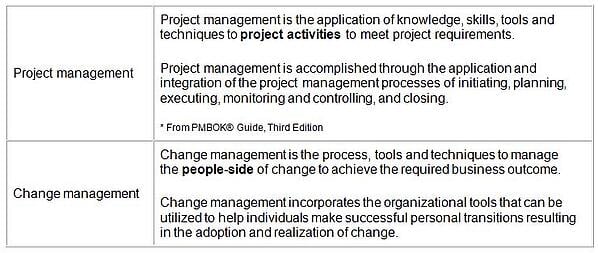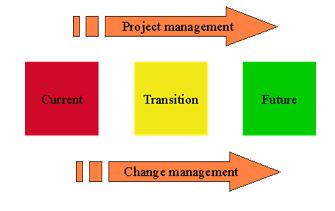Full Sail Partners Blog
Management of Change: The Project Manager's Perspective
 This series has been exploring how change management is viewed by a variety of perspectives: executives and finance to date with marketing, HR and IT yet to come. We’ve advocated that change must be understood and handled differently from each department’s “normal” day to day activities. However, for our focus on project management, this series will take a somewhat different turn. Project Managers already have, in their very work DNA, the ability to see, to scope, and to manage change. It’s what they do on a daily, weekly, and yearly basis: it’s what project management is all about.
This series has been exploring how change management is viewed by a variety of perspectives: executives and finance to date with marketing, HR and IT yet to come. We’ve advocated that change must be understood and handled differently from each department’s “normal” day to day activities. However, for our focus on project management, this series will take a somewhat different turn. Project Managers already have, in their very work DNA, the ability to see, to scope, and to manage change. It’s what they do on a daily, weekly, and yearly basis: it’s what project management is all about.
The specifics
Let’s first take a closer look at our terms – project management and change management – in order to make the clear connection. Tim Creasey, Director of Research and Development for Prosci Research takes us through this process.

From these terms, he offers next the vital connecting visual and description.

“As shown in this image, both project management and change management support moving an organization from a current state (how things are done today), through a transition state to a desired future state (the new processes, systems, organization structures or job roles defined by 'the change'). Project management focuses on the tasks to achieve the project requirements. Change management focuses on the people impacted by the change.
Any change to processes, systems, organization structures and/or job roles will have a 'technical' side and a 'people' side that must be managed. Project management and change management have evolved as disciplines to provide both the structure and the tools needed to realize change successfully on [both] the technical and people side[s].”
But there’s more
In our first piece, we offered a definitions of change management with user adoption as the important second step in the management of change. Once again, project managers are well positioned to ensure that not only are the processes of change implemented correctly, but that the people involved in the change are empowered to take full advantage.
As we’ve discussed, both project management and change management have as their leading characteristic, a specific focus on the people involved in the change. Also we stated in beginning of our series, user adoption requires a clearly defined and financially measured goal with training, clear communication/marketing and leadership buy-in as necessary parts to be successful. Each of these attributes is an important part of ensuring that the people part of change is not only smooth but wholly embraced: there is, after all, good reason that the company utilized valuable energy scoping out the change that will take your company from its present state to its future, more desired, state. And since a company is really the embodiment of the sum of its employees,
The company will only change
when the individuals fully and entirely
commit to the change.
Final phase
No project would be complete without this all-important final phase - project review. We all well know that no project would be complete without really looking at those phases which were well executed and which were not: it is here in the post-mortem where real learning occurs and where there is a final determination of success and of change.
Subscribe Here!
Latest Posts
Posts By Category
- Professional Services (225)
- Technology Solutions (154)
- Deltek Vision (125)
- Building Business (107)
- Accounting (92)
- Project Management (90)
- Deltek Vantagepoint (89)
- CRM (67)
- Press Release (62)
- ERP (52)
- HR (51)
- Client Relationships (47)
- Marketing (44)
- Professional Services Firms (32)
- Deltek Clarity Report (27)
- Support (20)
- A&E Firms (18)
- Employees (18)
- Business Intelligence (17)
- Cloud (17)
- Video (17)
- Deltek Talent (16)
- Mobile (15)
- Project Based Firms (13)
- Communication (9)
- Deltek Insight (9)
- Data Visualization (8)
- Project Information Management (PIM) (8)
- Case Study (6)
- Mergers and Acquisitions (6)
- Finance (5)
- Driving Growth (4)
- Resource Management (3)
- human resources (3)
- Connect Add-In (2)
- Human Capital Management (2)
- Proposal (2)
- Contract Management (1)
- Deltek + ComputerEase (1)
- Outsourced HR (1)
- Project Con (1)
- ProjectCon (1)
- SEO (1)
- THOUGHT LEADERSHIP (1)
- business development (1)
- password security (1)
Posts by Author
- Amanda Roussel (17)
- Amy Balassone (7)
- Aria Bounds (1)
- Bob Kottmeier (1)
- Bryce Crosby (1)
- Cate Phillips (7)
- Charlene Kerr (2)
- Chris Simei (2)
- Dale Busbey (5)
- Evan Creech-Pritchett (17)
- Full Sail Partners (106)
- Gina Stamper (1)
- Heath Harris (3)
- Jeff Robers (4)
- Jennifer Renfroe (64)
- Jennifer Wilson (1)
- Jenny Labranche (1)
- Joel Slater (7)
- Katie Sanner (1)
- Kelly Duquette (2)
- Kevin Hebblethwaite (8)
- Kim Stamps (1)
- Lee Frederiksen (1)
- Lindsay Diven (36)
- Lisa Ahearn (1)
- Matt McCauley (5)
- Michael Kessler, PMP (19)
- Nicole Temple (7)
- Peter Nuffer (3)
- Rana Blair (19)
- Rick Childs (8)
- Ryan Felkel (87)
- Ryan Suydam (10)
- Sarah Gonnella (66)
- Scott Gailhouse (20)
- Scott Seal (12)
- Sean Keller (1)
- Tasia Grant, PHR (14)
- Terri Agnew, CPA (9)
- Theresa Depew (8)
- Timothy Burns (5)
- Tom Vandervort (1)
- Wayne Johnstone (1)
- Wendy Gustafson (16)
- Wes Renfroe (16)


